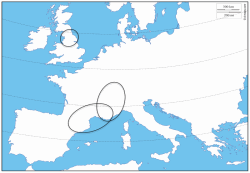Historical contradictions
The understanding of the contemporary reconfiguration of relations between sheep, wool and landscape as key to the sustainable renewal of rural regions, their economies and their forgotten cultures is contradictory.
Firstly, since the sixteenth century, England, Spain and Italy have been major actors in the emergence of a transnational market for woollen goods. The literature on this market suggests that the Lake District and Dales of northern England, the Catalan Pyrenees, and the Piedmontese Alps should be regarded as the hinterland of regions important to the evolution of modern, industrial production of woollen textiles of diverse sorts and changing quality. Piedmont and Catalonia are important to the evolution of the earliest forms of such production, but these proto-industrial endeavours also seem to have responded very differently to the challenges presented by the subsequent, accelerating globalization of manufacture and trade in woollen textiles, especially from the late eighteenth century onward. The first of these three regions, northern England, is instead renowned for its formative role in the mechanization of textile manufacture from the late eighteenth century onward. This role was facilitated greatly by the lifting of import tariffs on wool produced in British colonial possessions, which allowed for the emergence of Australia as the dominant producer globally. Of these three regions, only Piedmont seems to have maintained a profitable manufacture of woollen textiles to the present day.
Secondly, the existing literature also suggests that, over the period between the sixteenth century and the present day, the economics of ovine production have been ever less important to the cost of manufacturing woollen textiles. This has driven the transformation of both shepherding and the sheep themselves. The institutional organization of sheep grazing across Spain and the accompanying development of the Merino sheep from a regionally specific mode of managing ovine herds and their wool into a distinct breed is widely acclaimed as critically important to evolution of a transnational trade in wool and woollen textiles, first across Europe and then, beginning in the early nineteenth century, across the rest of the world. While the importance of the Merino to the evolution of herds outside Spain may have been overstated, and thus deserves closer attention, it seem that British endeavours to develop dual purpose sheep, capable of feeding both growing urban populations and local textile industries, was very important to the largely unsuccessful attempts to mitigate the impact of Australian production. Similarly, the rapidly declining prices for wool also seem to have driven the transformation of grazing practices across Spain, Italy and the United Kingdom, pushing ovine production onto increasingly marginal lands and relegating all that appertains to sheep to the margins of rural economies, seemingly disconnected from the demands of modern forms of agro-industrial production. The contemporary movement of grazing onto uplands in national parks, repositories of natural heritage, serves to emphasise such disconnection. As a result, grazing practices such as the movement of transhumant sheep along ever-narrower corridors have come to be regarded as relics of pre-modern forms of life, rather than studied adaptations to the demands of modern forms of agro-industrial production, transforming that which is historically contingent into an essential and immemorial feature of shepherding.
Viewed from this perspective, the precarious situation of ovine breeds unique to the Lake District and Dales of northern England, the Catalan Pyrenees, and the Piedmontese Alps is the result of specific and differentiated responses to the history of manufacture and trade in woollen textiles. It is not clear how the preservation of these breeds and the renewal of trade in woollen textiles support each other, except insofar as rarity itself can be rendered into a valuable commodity, but contradictorily so. The politics of securing protected designation of origin, a status that the Herdwick sheep, native of the Lake District, now enjoys, exemplifies such contradiction and illustrates the issues involved in the translocation noted above. By valorising a unique connection between product, time and place, external actors are attracted to the opportunity for profit by reproducing the cultural resonance of the model at a more remunerative scale, but in so doing they obscure the dependence of value upon attachment to the place of origin.

